Teleostei (teleosts) >
Centrarchiformes (Basses) >
Oplegnathidae (Knifejaws)
Etymology: Oplegnathus: Greek, hoplon = weapon + Greek, gnathos = jaw (Ref. 45335).
Eponymy: John Benjamin Romer Robinson (1869–1949) was a South African attorney and businessman. [...] (Ref. 128868), visit book page.
More on author: Regan.
Environment: milieu / climate zone / depth range / distribution range
Ecology
Marine; reef-associated; depth range 20 - 100 m (Ref. 4387). Subtropical
Western Indian Ocean: occurs only in Mozambique and Natal, South Africa.
Size / Weight / Age
Maturity: Lm ? range ? - ? cm
Max length : 60.0 cm TL male/unsexed; (Ref. 4387); common length : 40.0 cm TL male/unsexed; (Ref. 9660)
Occur in coastal rocky and coral reefs to a depth of 100 m; juveniles pelagic in currents (Ref. 4332). Benthic omnivores. May live longer than 10 years. Spawning occurs throughout the year (Ref. 57746). Marketed fresh (Ref. 9660).
Life cycle and mating behavior
Maturity | Reproduction | Spawning | Eggs | Fecundity | Larvae
Heemstra, P.C., 1986. Oplegnathidae. p. 632-633. In M.M. Smith and P.C. Heemstra (eds.) Smiths' sea fishes. Springer-Verlag, Berlin. (Ref. 4387)
IUCN Red List Status (Ref. 130435: Version 2025-1)
Threat to humans
Harmless
Human uses
Fisheries: commercial; gamefish: yes
Tools
Special reports
Download XML
Internet sources
Estimates based on models
Preferred temperature (Ref.
123201): 23.6 - 26.7, mean 25.8 °C (based on 16 cells).
Phylogenetic diversity index (Ref.
82804): PD
50 = 0.5156 [Uniqueness, from 0.5 = low to 2.0 = high].
Bayesian length-weight: a=0.01995 (0.00906 - 0.04395), b=3.01 (2.83 - 3.19), in cm total length, based on all LWR estimates for this body shape (Ref.
93245).
Trophic level (Ref.
69278): 3.2 ±0.42 se; based on food items.
Resilience (Ref.
120179): Low, minimum population doubling time 4.5 - 14 years (tmax > 10).
Fishing Vulnerability (Ref.
59153): Moderate vulnerability (44 of 100).
🛈
